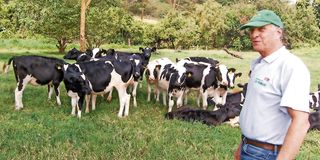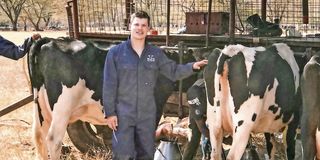Premium
Lessons from top cattle breeder

Hamish Grant, the farm owner and managing director of Gogar Farm, whose main specialisation is breeding. The 96-year-old farm, located three kilometres off the Nakuru-Eldoret Highway at the Salgaa junction, breeds top-quality holstein Friesian, Ayrshire and Jersey cattle. PHOTO | FRANCIS MUREITHI | NATION MEDIA GROUP
What you need to know:
- Gogar Farm in Nakuru breeds top quality holstein Friesian, Ayrshire and Jersey cattle for Kenyan and foreign markets
- Gogar Farm is a story of commitment to more integrated and sustainable cattle breeding technology.
- Grant, 62, is the founder of the Ilara Dairies, which he sold to Brookside Dairy after the death of his first wife Vanessa.
- Each animal has a traceable identification number which is displayed on the ear tag.
A lush green maize plantation welcomes you, stretching some 200 metres away from the gate, with dry Boma Rhodes grass sitting in the field on the opposite side of the driveway.
Welcome to Gogar Farm, one of the world’s top breeders of pedigree dairy cows.
The farm has a wide choice of pedigree in-calf heifers, both locally bred and imported, using Viking genetics sexed semen from Scandinavian countries.
The 96-year-old farm, located three kilometres off the Nakuru-Eldoret Highway at the Salgaa junction, breeds top-quality holstein Friesian, Ayrshire and Jersey cattle.
“When you breed for healthy cows, you invest in the future of your herd. You get fewer diseases for each generation so the investment will pay off more and more for each generation,” Hamish Grant, the farm owner and managing director of the enterprise, whose main specialisation is breeding, tells the Seeds of Gold.
And as he shows us around his 4,400-acre farm, we marvel at the quality of the breeds and of course the breathtaking ambience.
“This is a lucrative enterprise. This week, I sold 17 heifers to one of the top dairy farmers in Kenya at Sh330,000 each.”
The farm also sells sexed semen at between Sh4,500 and Sh5,000 and the unsexed variety for between Sh1,000 and Sh1,500 per straw. Bull calves are sold after four days at Sh4,500 each.
Gogar Farm is a story of commitment to more integrated and sustainable cattle breeding technology.
The farm has an aflatoxin testing machine for the feeds they buy and a microscope to detect diseases in the animals' blood samples.
The farm has an outstanding reputation that has attracted visitors from as far as South Africa, Finland, Tanzania, Britain, the Netherlands as well as local and international agricultural universities and State corporations.
HE HAS LESSONS
Grant then drives us around the farm, stopping to check on a cow here and there.
“With a massive farmland that has more than 1,300 animals, you don’t want to monitor activities from the comfort of your office,” says Grant, who has a rich livestock management background after studying Agriculture at London University.
Grant, 62, is the founder of the Ilara Dairies, which he sold to Brookside Dairy after the death of his first wife Vanessa.
And he has lessons for would-be large-scale dairy farmers.
“Large-scale dairy farming is an expensive enterprise that requires close supervision so that diseases do not disrupt you activities. We also have a strict feeding programme that we follow. We constantly monitor the weight of the cattle, water supply and adequate and quality pasture farming to ensure the animals feed on quality feeds,” he says.
The farm has an in-house vet who monitors the animal’s health.
He says he uses Rumen8 feeding programme where concentrates are properly mixed to ensure the cows’ dietary needs are met.
“This ensures the cow does not select the diet and overfeeds or underfeeds,” he says.
During the day, the animals graze on Naivasha star grass and in the evening they retire to the sheds where they are fed a ration full of minerals, salts and hay, which is mixed in special troughs.
A thorough vaccination regime has further helped the farm remain disease-free.
“Foot and mouth disease, anthrax, Rift Valley fever and lumpy skin disease are some of the most common diseases in Rongai and our animals are vaccinated accordingly.”
Each animal has a traceable identification number which is displayed on the ear tag.
“Besides, we have a herd book that documents their history, milk production, breed names, date of birth, parent breed, weight at birth, disease history and reason for disposing of it, among other details.”
The average milk production per cow per day is between 18 and 22 litres, even though some produce as high as 40 litres.
Grant says some of the challenges include poor vaccines and feeds with aflatoxin, noting that he has to test all, whether grown at the farm or bought.
IDENTIFY DAIRY CHARACTERISTICS
To ensure the farm has enough water for the animals, there are two big pans with a holding capacity of 250 million litres.
The farm, which employs about 190 workers, has a hay stock that can last for three years. At least 400 acres is under Boma Rhodes, 120 acres under the protein-rich lucerne and 2,000 acres is under maize.
The farm buys seeds from Kenya Seeds to ensure quality.
Juliana Opiyo, a livestock production specialist from Nakuru County, says farmers venturing into large-scale breeding must identify dairy characteristics like body conformity, gut, pin bone, hip bone, backline, udder conformation, suspension and general productivity.
“If it is Friesian, the black part must be predominantly on top to guard the namila against getting skin cancer,” says Juliana.

Visitors from Finland admire some of the dairy cattle kept in the farm. The farm has an outstanding reputation that has attracted visitors from as far as South Africa, Finland, Tanzania, Britain, the Netherlands as well as local and international agricultural universities and State corporations. PHOTO | FRANCIS MUREITHI | NATION MEDIA GROUP
For good breeding, a cow must have good dairy characteristics and high genetic potential of passing the same to its calves such as high milk production.
The body frame must have strong level thick top, long square level rump, smooth thick hind leg muscle, and a strong leg bone.
Placement of feet and legs should be square. It must also have well-sprung ribs, smooth shoulders and a long and lean neck and a feminine head and strong pasterns. It must eat a lot of forage to produce milk.
The udder must have medium tits which are symmetrical for ease of milking.
The farm must also be registered in the studbook record where the milk analysis – both qualitative and quantitative – is done. This is done to identify superior dams for commercial production.
Use of sexed semen or embryo transplant will ensure you get heifers.
Some of the good traits one should seek out for in the final calf include body conformation, for instance, a prominent hip bones and well placed tit, gut and udder formation. The backline should be straight and the hooves placement on the ground.
Experts advise that a cow that has poor body frame retains placenta when it is calving or has difficulties in calving.
Those that have injuries on the tits or any other deformity should never be used for breeding. A poor feeding cow and one with a history of diseases should also not be used.
Juliana says to get maximum returns, a large-scale farmer must have enough space to plant feeds for the animals. A farmer must also have a daily feeding and nutrition regime.
GOOD QUALITY FODDER
“Good quality fodder is crucial and cows fed from what you grow from the farm and supplemented with concentrates goes a long way. Fodder conservation, production, management and utilisation is key and the farmer must get it right.”
She says fodder must be stored in a dry place with enough air circulation and no direct sunshine to maintain quality.
A cow being prepared for breeding must have plenty of clean water and adequate supply of macro and micro nutrients. Macro nutrients such as calcium for body formation should be supplied in large quantities.
Micro nutrients such as zinc, copper and others are needed in small quantities. Energy feeds like grasses and grain should also be included in the feeding regime.
Concentrates like milling byproducts from oil crops should also be added. The cow should be well grown and be fed according to its body weight, with a specific daily ration and gaining weight preferably at 0.7kg per day.
It should not be underfed in the first three months after calving otherwise it will not go into heat or get pregnant easily.
For proper disease management, Nakuru County Director of Veterinary services Githui Kaba advises large-scale farmers to draw a vaccination programme for diseases such as foot and mouth Disease, lumpy skin and anthrax. Tick control is also crucial.
Dr Kaba says breeding requires a clean environment to beat diseases such as mastitis.
“Footbath and tyre bath is a necessity for large-scale farms to control spread of diseases,” Dr Kaba advises.





